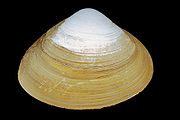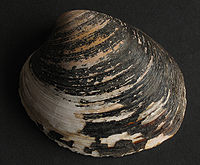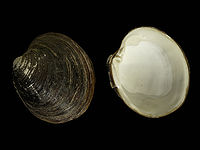
Periostracum
Encyclopedia




Brachiopod
Brachiopods are a phylum of marine animals that have hard "valves" on the upper and lower surfaces, unlike the left and right arrangement in bivalve molluscs. Brachiopod valves are hinged at the rear end, while the front can be opened for feeding or closed for protection...
s. Among mollusks it is primarily seen in snail
Snail
Snail is a common name applied to most of the members of the molluscan class Gastropoda that have coiled shells in the adult stage. When the word is used in its most general sense, it includes sea snails, land snails and freshwater snails. The word snail without any qualifier is however more often...
s and clam
Clam
The word "clam" can be applied to freshwater mussels, and other freshwater bivalves, as well as marine bivalves.In the United States, "clam" can be used in several different ways: one, as a general term covering all bivalve molluscs...
s, i.e. in bivalves and gastropods
Gastropod shell
The gastropod shell is a shell which is part of the body of a gastropod or snail, one kind of mollusc. The gastropod shell is an external skeleton or exoskeleton, which serves not only for muscle attachment, but also for protection from predators and from mechanical damage...
, but it is also found in cephalopod
Cephalopod
A cephalopod is any member of the molluscan class Cephalopoda . These exclusively marine animals are characterized by bilateral body symmetry, a prominent head, and a set of arms or tentacles modified from the primitive molluscan foot...
s such as the nautilus
Nautilus
Nautilus is the common name of marine creatures of cephalopod family Nautilidae, the sole extant family of the superfamily Nautilaceae and of its smaller but near equal suborder, Nautilina. It comprises six living species in two genera, the type of which is the genus Nautilus...
. Periostracum is an integral part of the shell, and it forms as the shell forms, along with the other shell layers.
Periostracum is visible as the outer layer of the shell of many molluscan species from terrestrial, freshwater and marine habitats, and may be seen in land snail
Land snail
A land snail is any of the many species of snail that live on land, as opposed to those that live in salt water and fresh water. Land snails are terrestrial gastropod mollusks that have shells, It is not always an easy matter to say which species are terrestrial, because some are more or less...
s, river mussels and other kinds of freshwater bivalves, as well as in many kinds of marine shelled mollusks.
The word "periostracum" means "around the bone", meaning that the periostracum wraps around the more calcareous part of the shell. Technically the calcareous part of the shell can (at least in theory) be referred to as the "ostracum", but that term is only very rarely used.
Composition
This shell layer is composed of a type of protein known as conchiolinConchiolin
Conchiolin and perlucin are complex proteins which are secreted by a mollusc's outer epithelium ....
. Conchiolin is largely composed of quinone
Quinone
A quinone is a class of organic compounds that are formally "derived from aromatic compounds [such as benzene or naphthalene] by conversion of an even number of –CH= groups into –C– groups with any necessary rearrangement of double bonds," resulting in "a fully conjugated cyclic dione structure."...
-tanned protein
Protein
Proteins are biochemical compounds consisting of one or more polypeptides typically folded into a globular or fibrous form, facilitating a biological function. A polypeptide is a single linear polymer chain of amino acids bonded together by peptide bonds between the carboxyl and amino groups of...
s, which are similar to those found in the epidermal
Squamous epithelium
In anatomy, squamous epithelium is an epithelium characterised by its most superficial layer consisting of flat, scale-like cells called squamous epithelial cells...
cuticle
Cuticle
A cuticle , or cuticula, is a term used for any of a variety of tough but flexible, non-mineral outer coverings of an organism, or parts of an organism, that provide protection. Various types of "cuticles" are non-homologous; differing in their origin, structure, function, and chemical composition...
.
Function
The formation of a shell requires certain biological machinery. The shell is deposited within a small compartment, the extrapallial space, which is sealed from the environment by the periostracum, a leathery outer layer around the rim of the shell, where growth occurs. This caps of the extrapallial space, which is bounded on its other surfaces by the existing shell and the mantle. The periostracum acts as a framework from which the outer layer of carbonate can be suspended, but also, in sealing the compartment, allows the accumulation of ions in concentrations sufficient for crystallization to occur. The accumulation of ions is driven by ion pumps packed within the calcifying epithelium. The organic matrix forms the scaffold that directs crystallization, and the deposition and rate of crystals is also controlled by hormones produced by the mollusc. The periostracum was probably essential in allowing early molluscs to obtain large size with a single valve.The periostracum is secreted from a groove in the mantle, termed the periostracal groove. When secreted, it consists of the soluble protein periostracin; this polymer becomes insoluble through a tanning process involving quinone.
Description
Periostracum is often yellowish or brownish in color. In some species it is black. The periostracum is very often a different color than the underlying layer of the shell.In the shells of species which have periostracum, this shell layer is quite often physically worn away or chemically eroded in the parts of the shell that are older, thus it may only still be visible in the more recently formed areas of the shell.
Periostracum can in some cases be quite thin, smooth, glossy and transparent, such that it looks almost like a thin yellow varnish
Varnish
Varnish is a transparent, hard, protective finish or film primarily used in wood finishing but also for other materials. Varnish is traditionally a combination of a drying oil, a resin, and a thinner or solvent. Varnish finishes are usually glossy but may be designed to produce satin or semi-gloss...
, or it can be thicker and more or less opaque. When it is thick it is often relatively rough in texture and dull. In some species the periostracum is tufted, or forms hair-like growths which in some cases can give the fresh shell a velvety feel, see. In some species the periostracum adheres very tightly to the underlying shell surface, in others the periostracum is less firmly attached.
In certain marine species, such as for example certain species of cone snail
Cone snail
Conidae is a taxonomic family of minute to quite large sea snails, marine gastropod molluscs in the superfamily Conoidea.The snails within this family are sophisticated predatory animals...
s, a heavy periostracum obscures the color patterns that exist on the calcareous layer of the shell.
In many aquatic species, once a shell has been removed from the water and has had time to completely dry out, then the periostracum may become brittle and start to flake or peel off of the surface of the shell.
It is not uncommon for shell collectors to deliberately remove a periostracum layer (using household bleach) if they feel that a shell is more attractive without it. However the periostracum is an important part of the shell, and is definitely of interest to malacologists. Details of the periostracum can sometimes be very helpful in identifying a species.
Hairs on gastropod shells
Haired shells occur in gastropods in several species of the StylommatophoraStylommatophora
Stylommatophora is a taxon of air-breathing land snails and slugs, terrestrial pulmonate gastropod molluscs. This taxon is currently considered to be a clade. It was previously regarded as an infraorder...
n families Polygyridae
Polygyridae
Polygyridae is a family of air-breathing land snails, terrestrial pulmonate gastropod mollusks in the superfamily Helicoidea.The Polygyridae make up a significant proportion of the land snail fauna of eastern North America, and are also found in western North America, northern Central America, and...
, Helicidae
Helicidae
The Helicidae, sometimes known as the typical snails, are a taxonomic family of small to large, air-breathing, land snails. In other words, they are terrestrial pulmonate gastropod mollusks....
and Hygromiidae
Hygromiidae
Hygromiidae is a taxonomic family of small to medium-sized air-breathing land snails, terrestrial pulmonate gastropod mollusks in the superfamily Helicoidea.-Anatomy:...
. These families are only distantly related, suggesting that this features has evolved several times independently. Haired shells are almost exclusively observed in species living in moist microhabitats, like layers of fallen leaves, broad-leaved vegetation, damp meadows or wet scree. Such a correlation suggests an adaptive significance of the trait in such a habitat; it was thus speculated that the hydrophobic hairs facilitate the movement in wet environments by relieving surface tension.
These hairs can reach varying densities (up to 20 per squaremilimetre) and lengths (up to three millimetres). In some cases hardly visible, they confer an almost furry impression to the shell in others. These semi-rigid structures are part of the periostracum, a thin protein layer (conchiolin
Conchiolin
Conchiolin and perlucin are complex proteins which are secreted by a mollusc's outer epithelium ....
) secreted by the snail to cover the calcareous shell. Building hairs requires the snail to have specialised glandular tissue and complex strategies to form them. Consequently, this trait can be assumed to be costly and should thus present a selective advantage to its bearers in order to be conserved.
Experiments by Pfenninger et al. (2005) on genus Trochulus showed an increased adherence of haired shells to wet surfaces. Haired shells appeared to be the ancestral character state, a feature most probably lost three times independently. The possession of hairs facilitates the adherence of the snails to their herbaceous food plants during foraging when humidity levels are high. The absence of hairs in some Trochulus species could thus be explained as a loss of the potential adaptive function linked to habitat shifts.
In brachiopods
The periostracum of brachiopodBrachiopod
Brachiopods are a phylum of marine animals that have hard "valves" on the upper and lower surfaces, unlike the left and right arrangement in bivalve molluscs. Brachiopod valves are hinged at the rear end, while the front can be opened for feeding or closed for protection...
s is made of chitin
Chitin
Chitin n is a long-chain polymer of a N-acetylglucosamine, a derivative of glucose, and is found in many places throughout the natural world...
. Relatively new cells on the edges of the brachiopod mantle secrete material that extends the periostracum, but are displaced on the upper side of the mantle by more recent cells, and switch to secreting the mineralized material of the shell valves.

